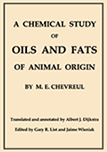A Chemical Study of Oils and Fats of Animal Origin by M.E. Chevreul
The Editors: Albert J. Dijkstra and Gary R. List

Translated and annotated by Albert J. Dijkstra, 2009
ISBN 978-2-9533244-0-2, 348 pages
Edited by Gary R. List and Jaime Wisniak
Preface
In 1811, when Michel Chevreul began his research, the chemical nature of fats, oils and lipids was unknown. Some 12 years later he published his classic work based on a series of publications that appeared in Annales de chimie during the period from 1813-1823. This work entitled: “Recherches chimiques sur les corps gras d’origine animale” is of interest not only for establishing the chemical nature of fats but also from a historical point of view by giving an insight into the mind of one of the premier organic chemists of the early 19th century. Berzelius commented that Chevreul’s work should serve as a model for young chemists wishing to do research in any field of chemistry and went on to say that Chevreul’s investigations were the most complete and best executed series of experiments in all of chemistry.
Von Liebig also had glowing comments about Chevreul’s work: “Chevreul has shown the connection between the saponification products and their mode of formation and that work was the starting point of all subsequent research and the basis for all prevailing methods of analysis and investigations of organic materials.” We must thank Chevreul for the beautiful principles underlying every organic investigation. Other contemporaries declared: “Chevreul’s work is a masterpiece.”
It is therefore most surprising that this masterpiece has never been translated into English. It was reprinted in 1825, in 1886 on the occasion of the author’s 100th birthday and again in 1986. It has also been published as a pdf file and can be accessed via http://books.google.com but all these publications are in French, which limits their accessibility; a translation into English is therefore long overdue. Accordingly, the American Oil Chemists' Society has taken the laudable initiative of distributing our translation of this masterpiece on the occasion of its own centenary.
However, translating this book is complicated not only because it is written in 19th century French but also since it requires knowledge of contemporary 19th century chemistry. Dr Albert Dijkstra has responded to both of these challenges by translating the text into a more modern and readable form and by annotating the work in the light of modern chemical knowledge. The translator and the editors hope the reader will enjoy this remarkable contribution to the history of lipid chemistry.
Gary R. List
Foreward (.pdf)
BOOK I
- Chapter 1 Definitions (.pdf)
- Chapter 2 Description of the analytical method to determine the elemental composition of oils and fats (.pdf)
BOOK II
- Chapter 1 Stearic acid and some stearates (.pdf)
- Chapter 2 Palmitic acid and some palmitate (.pdf)
- Chapter 3 Oleic acid and some oleates (.pdf)
- Chapter 4 Phocenic acid and some phocenates (.pdf)
- Chapter 5 Butyric acid and some butyrates (.pdf)
- Chapter 6 Caproic acid and some caproates (.pdf)
- Chapter 7 Capric acid and some caprates (.pdf)
- Chapter 8 Hircic acid (.pdf)
- Chapter 9 Cholesterol (.pdf)
- Chapter 10 Ethal (.pdf)
- Chapter 11 Cetin (.pdf)
- Chapter 12 Mutton tallow stearin (.pdf)
- Chapter 13 Human fat stearin (.pdf)
- Chapter 14 Olein (.pdf)
- Chapter 15 Phocenin (.pdf)
- Chapter 16 Butyrin (.pdf)
- Chapter 17 Hircin (.pdf)
BOOK III
- Chapter 1 Preparation of fatty acids and analysis of the saponification products of the fatty material of the 5th and 6th genera (.pdf)
- Chapter 2 Preparation and saponification of spermaceti (.pdf)
- Chapter 3 Direct analysis of fats that are primarily composed of sterin and olein and preparation of those substances (.pdf)
BOOK IV
- Chapter 1 (.pdf)
- Chapter 2 Study of cow’s milk and preparation of butyrin (.pdf)
- Chapter 3 Study of several cetacean oils (.pdf)
- Chapter 4 Examination of cadaver fat and adipocere (.pdf)
BOOK V
Part One Saponification considered with respect to the fatty materials
- Chapter 1 (.pdf)
- Chapter 2 Some general observations regarding saponification (.pdf)
- Chapter 3 On saponification (.pdf)
Part Two Saponification with respect to bases that can form salts
- Chapter 4 The effect on lard of several bases that can form salts (.pdf)
- Chapter 5 On the amount of fat that a given amount of potassium hydroxide can saponify (.pdf)
- Chapter 6 Can saponification be realized by potassium bicarbonate and ammonium carbonate? (.pdf)
BOOK VI
